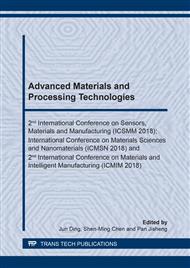[1]
A. Tewari, A.M. Gokhale, Estimation analysis of three-dimensional grain size distribution for microstructural serial sections, Mater. Charact. 46 (2001) 329-335.
DOI: 10.1016/s1044-5803(01)00104-8
Google Scholar
[2]
D.M. Saylor, A. Morawiec and G.S. Rohrer, The distribution and energies of grain boundaries as a function of five degrees of freedom, J. Am. Ceram. Soc. 85 (2002) 3081-3083.
DOI: 10.1111/j.1151-2916.2002.tb00583.x
Google Scholar
[3]
D.J. Rowenhurst, A. Gupta, C.R. Feng and G. Spanos, 3D crystallographic and morphological analysis of coarse martensite: combining EBSD and serial sectioning, Scripta Mater. 55 (2006) 11-16.
DOI: 10.1016/j.scriptamat.2005.12.061
Google Scholar
[4]
H. Moulinec, P. Suquet, A numerical method for computing the overall response of nonlinear composites with complex microstructure, Comput. Methods Appl. Mech. Eng. 157 (1998) 69-94.
DOI: 10.1016/s0045-7825(97)00218-1
Google Scholar
[5]
J.C. Michel, H. Moulinec and P. Suquet, A computational method based on augmented Lagrangians and Fast Fourier Transforms for composites with high contrast, Comput. Mod. Eng. Sci. 1 (2000) 79-88.
Google Scholar
[6]
R.A. Lebensohn, M. Motagnat, P. Mansuy, P. Duval, J. Meysonnier and A. Philip, Modeling viscoplastic behavior and heterogeneous intracrystalline deformation of columnar ice polycrystals, Acta Mater. 57 (2009) 1405-1415.
DOI: 10.1016/j.actamat.2008.10.057
Google Scholar
[7]
Q. Meng, Z. Wang, Prediction of interfacial strength and failure mechanisms in particle-reinforced metal-matrix composites based on a micromechanical model, Eng. Fracture Mechanics 142 (2015) 170-183.
DOI: 10.1016/j.engfracmech.2015.06.001
Google Scholar
[8]
J. Zhang, Q. Ouyang, Q. Guo, Z. Li, G. Fan, Y. Su, L. Jiang, E.J. Lavernia, J.M. Schoenung and D. Zhang, 3D Microstructure-based finite element modeling of deformation and fracture of SiCp/Al composites, Composites Sci. Tech. 123 (2016) 1-9.
DOI: 10.1016/j.compscitech.2015.11.014
Google Scholar


